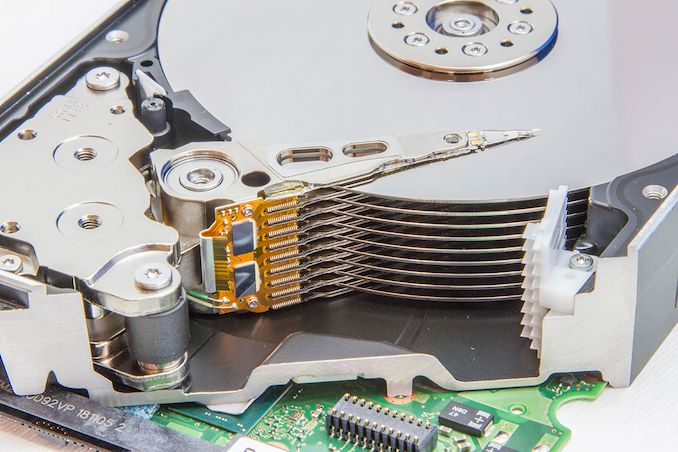Western Digital this week said that its energy-assisted magnetic recording (ePMR) and OptiNAND technologies coupled with increased number of platters per hard drive would enable it to build HDDs with an up to 30 TB capacity. To keep advancing capacities from there, the company will need to use heat-assisted magnetic recording (HAMR), it revealed. Meanwhile, it never mentioned microwave-assisted magnetic recording (MAMR) that was expected to precede HAMR.
Building a 22TB HDD for 2022
Last month Western Digital's began shipping its top-of-the-range Ultrastar DC HC560 20TB and WD Gold 20TB hard drives that rely on nine 2.2 TB ePMR platters and feature the company's OptiNAND technology that uses an embedded flash drive (EFD) to increase performance, reliability, and usable capacity of an HDD.
To boost capacity of its next-generation hard drives further, Western Digital can either install disks with a higher areal density or increase the number of disks per drive. Both approaches have their challenges (higher areal density might require new heads, whereas an additional platter requires usage of thinner media and mechanical parts), but it looks like the company has a way to put 10th disk into a 3.5-inch HDD.
"We are able to deliver our 20TB on nine platters, we can add the 10th [disk], and we get another 2.2TB of storage," said David Goeckeler, chief executive of Western Digital (via SeekingAlpha), at the 5th Annual Virtual Wells Fargo TMT Summit Conference.
Building a 22TB HDD on a 10-disk platform is a viable way to offer some additional capacity for its customers and stay competitive in 2022. But Western Digital's existing technologies have a considerably more serious potential.
Up to 30TB
When Western Digital introduced its OptiNAND technology earlier this year, it talked about its benefits (which include performance, reliability, and capacity) but did not really quantify them. This week the company finally spilled some beans on the potential of its ePMR technology combined with OptiNAND. As it turns out, it can build 30 TB hard drives using what it already has: ePMR, OptiNAND, and a 10-platter 3.5-inch HDD platform. This will require it to increase areal density of its ePMR disks by about 36%, which is significant.
"So, we really have that staircase to take you to 30TB and then you get on the HAMR curve and you go for quite a bit longer," said Goeckler. "So, I think it is a really good roadmap for the hard drive industry."
MAMR Axed?
For years Western Digital envisioned that its MAMR technology as a key enabler of its hard drives with an up to 40TB capacity. In 2019 it introduced its ePMR technology that was considered to be a half-way towards MAMR, but since then the company has barely mentioned MAMR at all.
When it announced its OptiNAND technology, Western Digital mentioned MAMR as one of the energy-assisted magnetic recording options it was looking at, but did not reveal any actual plans. At the virtual Wells Fargo summit, Western Digital stressed that HAMR was a key enabler for its future HDDs that have capacity of over 30TB, but did not talk about MAMR at all.
"HAMR is extremely important, great technology, it is still several years away before it is commercialized, and you can bet your datacenter on it," said Goeckler. "We have heavily invested in HAMR. I think you know we have over 400 patents in HAMR. [If] you are a supplier of hard drives in an industry this big, you are going to [invest] in a number of different technologies that you think is going to fuel your road map. So, we are a big believer in HAMR."
If Western Digital can keep expanding capacity of its hard drives with its ePMR technology for a few years before it can roll out its first HAMR-based drives, then it does not need to commercialize its MAMR technology at all since HAMR has considerably better scalability in terms of aerial density.
Like every new magnetic recording technology, MAMR and HAMR need to be evaluated by Western Digital's customers before getting to mass production, which takes time. Therefore, it is not in the company's interests to introduce new HDD platforms or new recording technologies too often as this slowdowns adoption of its drives by clients as well as revenue growth.
We have reached out to Western Digital to clarify its plans for MAMR, but the company has yet to respond to our request.
from AnandTech https://ift.tt/3DiEXze
via IFTTT

0 comments:
Post a Comment